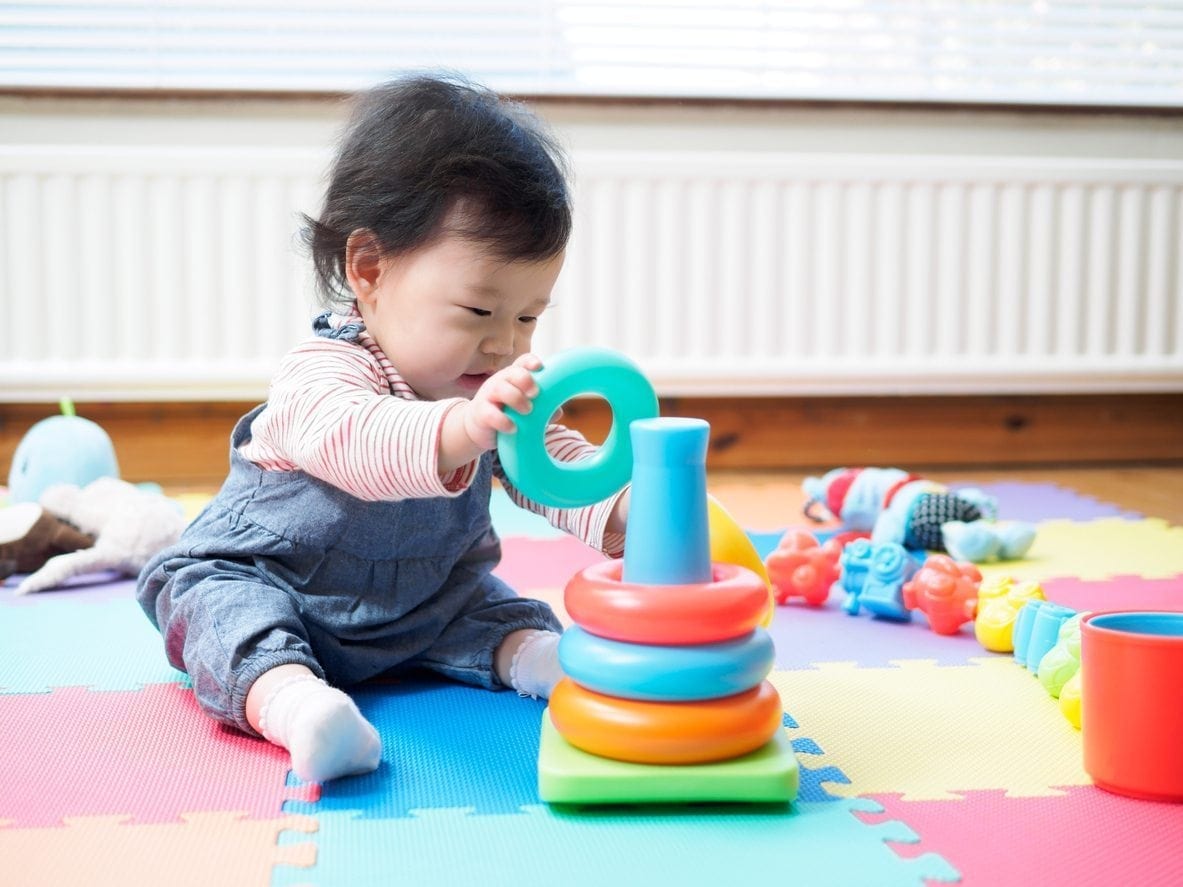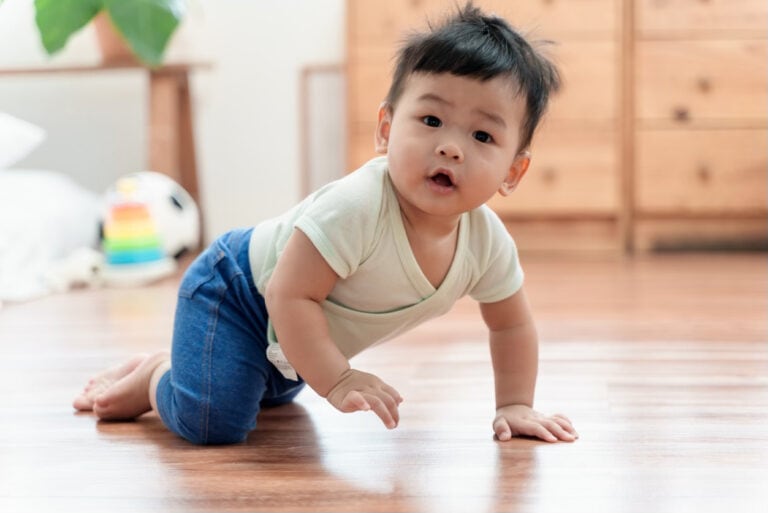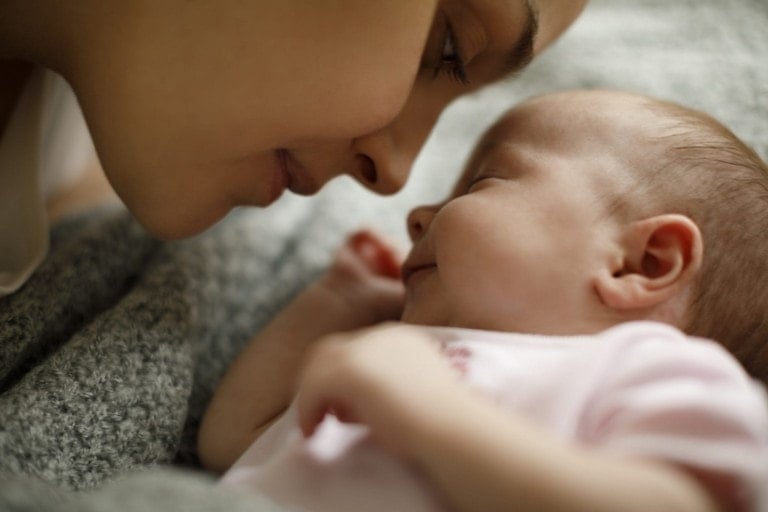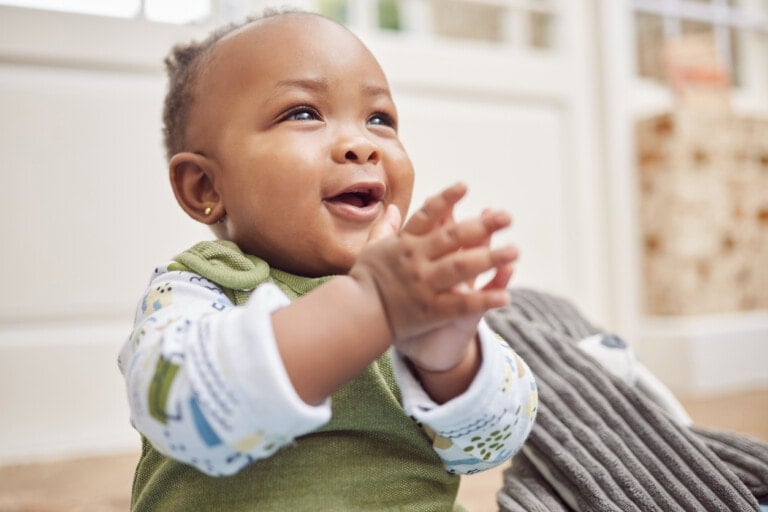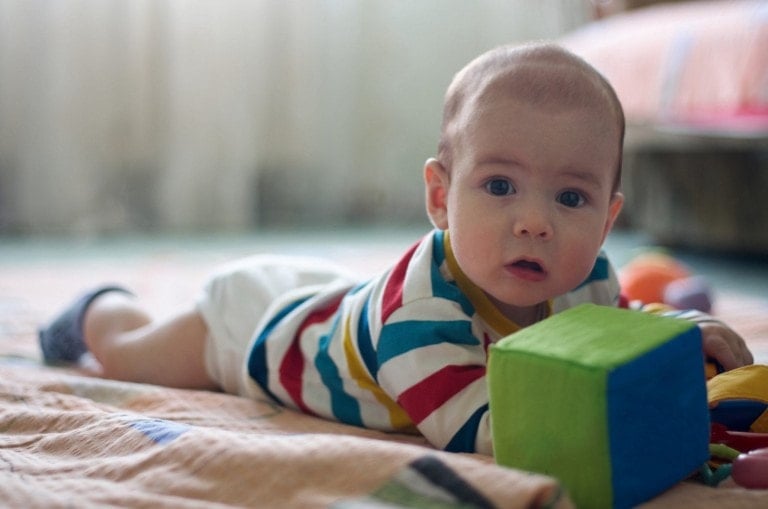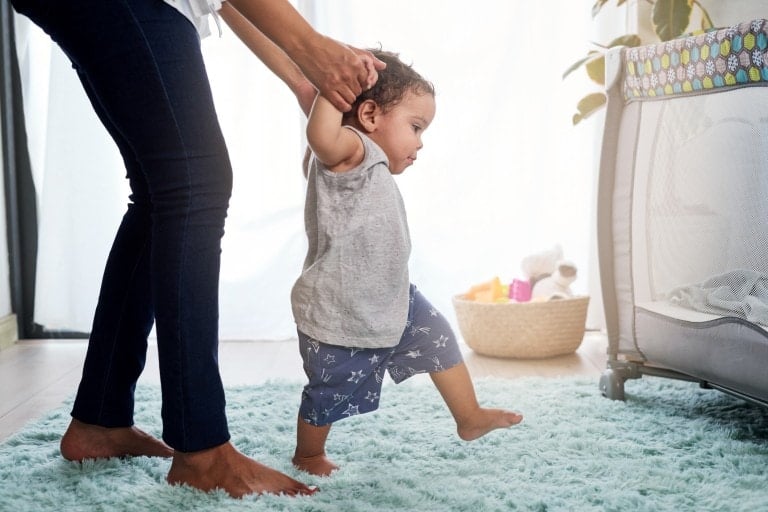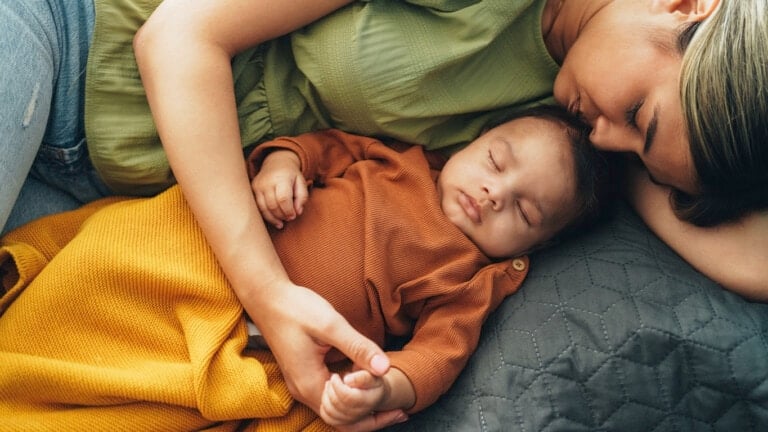Watching your baby develop during a year full of “first everything” is exciting. Babies grow so fast that they seem to progress at warp speed. This can throw budding routines off when you think you finally have things under control! So, how do you know if your baby is meeting age-appropriate baby milestones in the first year?
Healthcare providers use developmental milestones to assess whether your child is growing and developing as expected. Physical, cognitive, communicative/language, social, emotional, and sensory skills enable humans to interact successfully with the world. Developmental milestones provide a framework and general timeline of when children should accomplish these skills for normal development.1,2,3,4,5,6
This article will provide milestones for each month so you know what to expect in your baby’s first year. However, it is essential to remember that all babies are different, and your child may move ahead in one area while being slightly behind in another. Variations are not typically a concern if skills are accomplished within an acceptable time frame on a developmental milestones chart.2,3,5
Keeping Track of Baby Milestones
Some excellent baby milestone tracker apps for smartphones and online charts are available, making it easier for parents to record their baby’s progress. Recording baby milestones enables you to celebrate all their firsts, provide your doctor with accurate information, and identify any possible needs or delays early. Talk to your doctor if you are concerned about your baby’s progress. If your provider notices an area of concern, early identification and intervention are helpful. They may refer them to specialists like a physical therapist, occupational therapist, or a speech-language therapist.1,2,3,4,5
Babies born prematurely may take longer to reach milestones. Neonatal intensive care unit graduates sometimes need specialized developmental follow-ups, and your healthcare team should have information tailored to your little one’s needs.4
Babies build on their skills and developmental milestones as they grow. The following information is a guide; you will notice some overlap between months because milestones are like building blocks — one milestone provides the foundation for another. It is best to speak with your pediatrician if you have specific concerns. But if you want to understand when babies start rolling over, when babies start sitting up, and when they can hold their heads up, read on.
1-Month-Old Baby Milestones
During the first month, you are getting to know your baby and vice versa. Some of your child’s milestones include:3,4,5,6
- Making equal movements of their arms and legs on each side of their body
- Making tight fists with both hands
- Holding their head up for a short time (a few seconds) while in a car seat or on their tummy
- Sucking on their hands
- Successfully feeding with a coordinated suck-swallow-breathe pattern
- Maintaining eye contact when held by parents at a distance of 8-12 inches
- Being interested in faces
- Staring at an object or toy when it’s held closely to their face (8-12 inches)
- Turning their head toward the sound of your voice
- Startling at loud noises
- Responding to comforting actions by parents
Continue reading about 1-Month-Old Baby: Feeding, Sleep, and Milestones
2-Month-Old Baby Milestones
Now, your baby is growing quickly and gaining weight. Baby milestones at 2 months of age include:2,3,6
- Opening their hands briefly
- Clasping their hands together
- Making equal movements of their arms and legs
- Holding their head up shortly during tummy time
- Potentially moving their head side to side or lifting their chest slightly while on their stomach
- Looking at an object or toy for several seconds
- Making other sounds besides crying, including “cooing”
- Startling at loud noises
- Possibly having different cries for hunger, needing a diaper change, being tired, or needing comfort
- Smiling at parents when parents talk and interact with them
- Calming down when comforted by parents
- Sleeping a little longer, potentially
Continue reading about 2-Month-Old Baby: Feeding, Sleep, and Milestones
3-Month-Old Baby Milestones
Your baby is getting stronger and responding more to their environment at 3 months old. Some exciting baby milestones include:4,5,6
- Opening and closing their hands
- Being able to grab an object or toy
- Swinging their arms at low-hanging or dangling toys
- Increased head control
- Lifting their head and chest when lying on their belly
- Their eyes tracking side to side when they’re following a toy
- Recognizing their parents
- Hand-eye coordination beginning
- A longer ability to focus
- Starting to copy sounds when responding to you
- Making a variety of noises
- Starting to chuckle and develop facial expressions
- Smiling on their own
Continue reading about 3-Month-Old Baby: Feeding, Sleep, and Milestones
4-Month-Old Baby Milestones
By 4 months of age, your baby is gaining more coordination. They have more control over their body and are beginning to show emotions such as contentment, excitement, and frustration. Your child should be on their way to accomplishing the following baby milestones:2,3,6
- Better head control
- Interest in their own hands and feet
- Bringing their hands to their mouth
- Trying to bring objects to their mouth
- Becoming stronger
- Turning toward the direction of sounds
- Improved eyesight and eye contact
- Making “ooh” and “aah” noises
- Trying to imitate sounds
- Laughing and chuckling
- Smiling to get your attention
- Enjoying looking at their face in a mirror
- Showing emotions
Continue reading about 4-Month-Old Baby: Feeding, Sleep, and Milestones
5-Month-Old Baby Milestones
The changes in your baby are coming rapidly now, and these next few months are filled with memory-making achievements. They are likely outgrowing clothes and diapers quickly, as many babies are now double their birth weight.6 Developmental milestones at 5 months of age include:4,5,6
- Straightening or arching their back and being more wiggly during tummy time
- Developing skills for sitting and rolling over
- Simply and quickly moving objects to their mouth
- Shaking a toy or object
- Delighting in toys that make sounds
- Possibly crying if they’re left alone or if parents leave the room
- Potentially lifting their arms to show they want to be held
- Developing a laugh
- Trying to repeat actions like blowing raspberries over and over
Continue reading about 5-Month-Old Baby: Feeding, Sleep, and Milestones
6-Month-Old Baby Milestones
Babies can recognize their parents at six months, roll over, and are more active. Squirmy babies can roll over unexpectedly, so always keep them safe when changing diapers at a height. They can surprise you sometimes, so always be mindful of their safety.5,6 More baby milestones for your 6-month-old include:1,2,3,4,5,6
- Improved coordination
- Rolling over from their tummy to their back
- Being able to pass a toy from one hand to the other
- Beginning to sit up while supported
- Laughing and squealing
- Recognizing their parents and siblings
- Possibly getting anxious around unfamiliar people
- Using different sounds to express emotions
- Being ready for you to start introducing solid foods
- Tightly closing their mouth and lips if they do not want food
Continue reading about 6-Month-Old Baby: Feeding, Sleep, and Milestones
7-Month-Old Baby Milestones
Your 7-month-old is growing fast, probably taking some solid foods and curious about their world, making this a busy and exciting time for parents. You can anticipate the following milestones by about seven months:5,6
- Getting their first tooth
- Shuffling to move their body and beginning to learn to crawl
- Rolling over
- Picking up toys or objects with one hand
- Banging things (like blocks) things together
- Improving memory
- Enjoying hide-and-seek games, such as peek-a-boo or a toy that hides and then pops up
- Making a variety of sounds to mimic language
Continue reading about 7-Month-Old Baby: Feeding, Sleep, and Milestones
8-Month-Old Baby Milestones
Your 8-month-old is likely on the move or getting close, and they may be holding heartwarming babbling conversations with you. Baby milestones at eight months include:4,5,6
- Moving a lot!
- Sitting up
- Possibly pointing at objects they want
- Improved eyesight
- Potentially starting to use furniture to pull themselves up to a standing position
- Having babbling conversations in response to you
- Feeling most comfortable with parents and possibly crying when they are apart from you
Continue reading about 8-Month-Old Baby: Feeding, Sleep, and Milestones
9-Month-Old Baby Milestones
By nine months, many babies start to scoot on their bottoms, and if you have not baby-proofed your home, now is the time. Your baby is getting busy and progressing quickly.6 You can look forward to the following baby milestones by 9 months of age:1,2,3,4,5,6
- Sitting without support
- Starting to crawl or already crawling
- Being able to use their thumb and fingers to pick up an object like finger food (pincer grasp)
- Delighting in games of “pass the object” from them to you and vice versa
- Being able to focus on things at a greater distance
- Having more interest in colors and shapes
- Turning their head to follow a moving object, including parents
- Learning to say “no” by shaking their head
- Making sounds like “ba-ba” or “ma-ma”
- Possibly feeling nervous around unfamiliar people
- Potentially showing separation anxiety when not with their parents
Continue reading about 9-Month-Old Baby: Feeding, Sleep, and Milestones
10-Month-Old Baby Milestones
At 10 months, your baby is probably giving you a bit of a workout as you chase them around while they explore the world and figure out what their body can do. Your baby should be on the way to accomplishing the following baby milestones:4,5,6
- Crawling
- Pulling up on furniture to stand
- Easily pick up and put objects in their mouth
- Clapping their hands
- Possibly bouncing to music
- Enjoying being read to
- Being interested in how toys work
- Communicating through facial expressions, body language, and sounds
- Potentially beginning to say their first words
- Responding when parents say “no”
- Still being frightened of strangers and possibly crying when apart from parents
Continue reading about 10-Month-Old Baby: Feeding, Sleep, and Milestones
11-Month-Old Baby Milestones
By 11 months, your baby’s senses are more developed, and they may have specific likes and dislikes regarding smells and tastes.6 Look for the following developmental milestones around 11 months:4,5,6
- Using furniture like a coffee table as a support to walk or “cruise” around
- Dropping objects into a container or bucket
- Enjoying music and books with pictures or pop-up pictures
- Possibly holding a sippy cup on their own
- Vision and depth perception near that of an adult
- Enjoying stringing several sounds together
- Possibly understanding “no”
- Potentially using grunting noises to alert parents to a need
- Using non-verbal communication like waving, pointing, or nodding
- Feeling most secure with parents (chance of separation anxiety)
Continue reading about 11-Month-Old Baby: Feeding, Sleep, and Milestones
12-Month-Old Baby Milestones
Your baby is likely about three times their birth weight, and you may find it hard to believe how much they have grown and accomplished in their first year. When celebrating your baby’s first birthday, you can anticipate the following milestones:1,2,3,4,5,6
- Play games like pat-a-cake
- Enjoying being read to
- Pointing to a picture when asked, like “Point to the dog”
- Improved attention span that has increased to two to five minutes
- Improved fine motor skills
- Picking up objects with their thumbs and fingers
- Picking up, dropping, throwing, and banging objects or toys
- Holding utensils
- Sipping from a regular cup with help
- Using furniture to support walking
- Taking their first steps
- Standing unassisted
- Chatting in gibberish but may start to say a few words
- Reassured by their parent’s presence
Your child’s first year is a beautiful time when you bond with your little one as their personality progresses. They look to you for guidance and support as they go from a dependent newborn to a curious and active 1-year-old. The first year is a learning curve for parents, and you are not expected to know everything. Tracking developmental milestones can help reassure you that your child is on the right track. Many online resources and apps also provide parents with ideas and games to guide development. Contact your healthcare provider if your child is not meeting their baby milestones.













